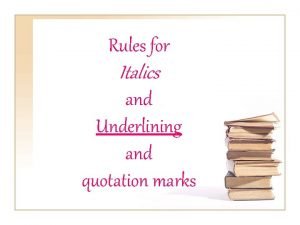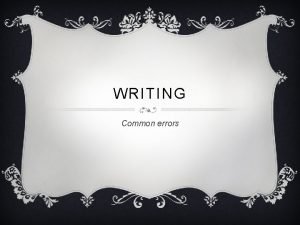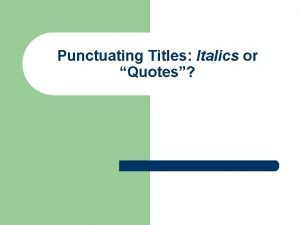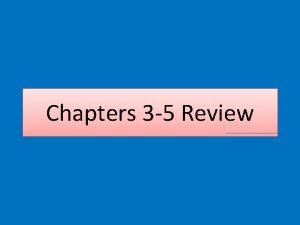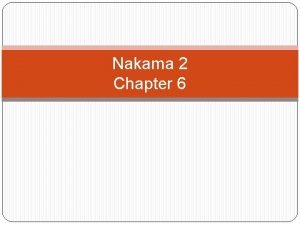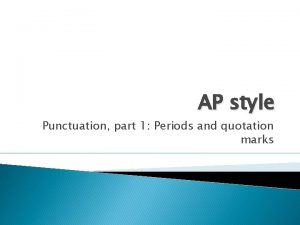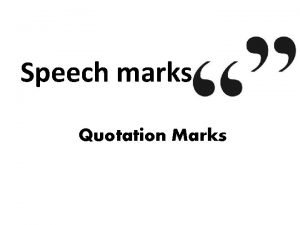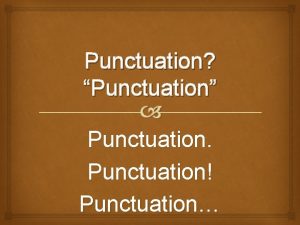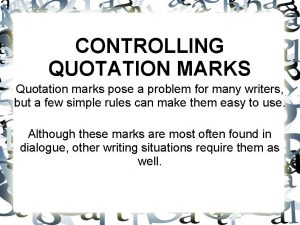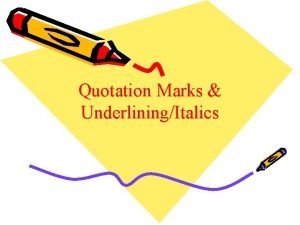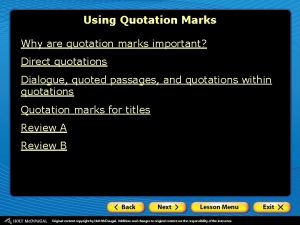PUNCTUATING TITLES Underlined Quotation marks Chapter No Punctuation









- Slides: 9

PUNCTUATING TITLES Underlined “Quotation marks” Chapter No Punctuation Religious works Works of art e. g. paintings Photograph Buildings Novel Short story Monument Newspaper story Individual show episode Article Or Italicized Book TV Series Magazine Lecture One

THESIS STATEMENTS - Thesis statement is in the introduction and is the most important sentence in you essay - It tells the readers what is your essay is going to be about. - By reading thesis statement, the reader should be able to recognize the main idea of the whole essay as well as the subtopics. - The thesis statement contains two parts: 1) The topic ( the general subject) 2) The approach (writer’s attitude about the topic and indicate how the writer will develop the essay). Example: Native Americans have made many valuable contributions to U. S culture. (GENERAL only main idea ) Native Americans have made many valuable contributions to U. S culture, particularly in the areas of language, art, food, and government. ( Main idea and subtopics )

THESIS STATEMENTS Sometimes we use Colon (: ) before lists in thesis statement. Native Americans have made many valuable contributions to U. S culture, particularly in three areas : language, art, food, and government. Thesis statement indicates also the pattern of organization that the essay will follow e. g. causes and effect, problem and solution, comparison and contrast, spatial order (i. e. place and position), or chronological order (i. e. time ). Examples: - There are several differences between a nurse practitioner and a physician’s assistant. - In order to minimize gang violence, schools should require uniforms, set strict rules, and stimulate family participation.

PARALLELISM What is parallelism? It means that each item in a list or comparison follows the same grammatical pattern (i. e. the same word class). Examples: 1)……………………………………. . 2)……………………………………. . Exercise: In the booklet.

EXERCISE PARALLELISM 1) People may have two choices to eat, either they go out to fast food stands or restaurants, or they prepare food at home. Personally, I prefer to go out to eat, as it is easy to get , it saves my time, and I can try variety of interesting food of different countries. 2) If you have a good neighbor, you are a lucky person. You have someone who cares about your property, who volunteers to help at anytime, and who is supportive in times of crisis.

EXERCISE PARALLELISM 1) A computer is necessary for college students for three reasons: w riting research, dropping and adding courses, and sending emails for their lecturers and colleagues. 2) To survive a major disaster such as earthquake requires: p repare in advance what to do, keep calm when it happens, and find safer place.

INTRODUCTIONS Types of Introductory Paragraphs 1 - Background Information Introduction: Presents background on the topic that slowly leads up to thesis. 2 - Quotation Introduction: Must be directly related to the main idea of the essay; it can be from reading that you have done to prepare for your essay or it can be from a well-known saying, an appropriate remark from a famous person, or a line from a song or a poem. 3 - Definition Introduction: Prepares the reader for applications and examples of the concept or term being defined.

INTRODUCTIONS 4 - Summary Introduction : Summarizes a reading selection (or a lecture, speech, or movie) and prepares the reader for an analysis or discussion of what has been summarized. 5 - Funnel Introduction: The funnel introduction begins with one or two very general sentences about the topic. Each subsequent sentence becomes increasingly focused on the topic until the last sentence, which states very specifically what the essay will be about. 6 - Dramatic, Interesting, and Funny story Introduction: A dramatic, humorous, or otherwise interesting opening will generate interest in the reader. It is important, after all, to capture the reader’s attention.

INTRODUCTIONS 7 - Surprising Statistic or Facts Introduction 8 - Historical Background. 9 - The turnabout Introduction: This type of introduction opens with a few sentences summarizing a point of view that is actually the opposite of the writer’s own thesis. By the end of the introduction, the writer makes a complete turnabout and presents his or her thesis – the opposite of what he or she started out with. This technique is useful when the writer’s purpose in the essay is to argue a point or to clear up a commonly held misconception.
